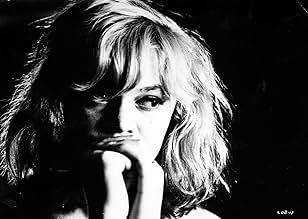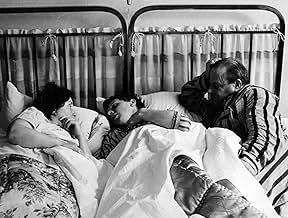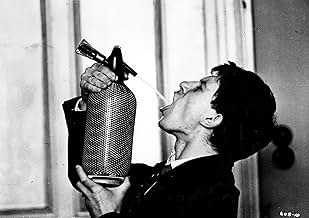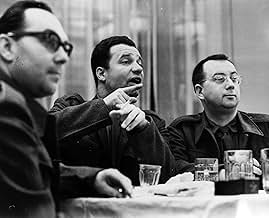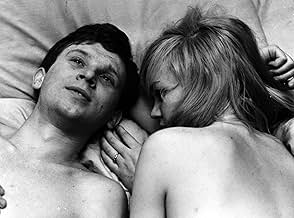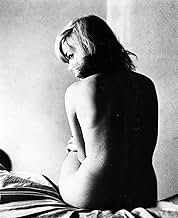CALIFICACIÓN DE IMDb
7.4/10
10 k
TU CALIFICACIÓN
El gestor de una fábrica en una zona rural de Checoslovaquia pide al ejército que mande hombres a la zona para subirles la moral a las trabajadoras, que no han tenido compañía desde que los ... Leer todoEl gestor de una fábrica en una zona rural de Checoslovaquia pide al ejército que mande hombres a la zona para subirles la moral a las trabajadoras, que no han tenido compañía desde que los hombre fueron reclutados.El gestor de una fábrica en una zona rural de Checoslovaquia pide al ejército que mande hombres a la zona para subirles la moral a las trabajadoras, que no han tenido compañía desde que los hombre fueron reclutados.
- Dirección
- Guionistas
- Elenco
- Nominado a 1 premio Óscar
- 2 premios ganados y 4 nominaciones en total
Jana Novaková
- Jana
- (as Jana Nováková)
Jindrich Heidelberg
- Reditel
- (sin créditos)
Dana Valtová
- Bohunka
- (sin créditos)
Opiniones destacadas
10jtur88
I don't think I've ever seen a movie that so faithfully captured the sense of place. I spent many months in the mid-60's in Czechoslovakia and Eastern Europe, and when I recently saw this film, it brought tears of nostalgia to my eyes. The scene in the parents' house, when the family was faced with the arrival of the unexpected stranger, is documentary in its portrayal of how a household would look in those times, complete to the smallest details of housekeeping and behavior. It is light-hearted without being slapstick, and it is poignant without being corny. Every character is right on the mark. On my very very short list of the greatest movies ever. In short, it is perfect. See this film, and take the whole family.
This is such an exquisite cinematic weave of feelings, I was taken aback. But only half of it is there, the rest you'll have to supply which is even better in a way. Films come into being after all in that space between what is there and the experience in the eye.
But first. Watch it once straight through because it's funny as hell in that gentle way the Czech know so well, just light and bitter enough to be like getting tipsy on life, delighted at the tipsiness. It's well made and well acted, you can see why Milos Forman was quickly tapped by Hollywood.
Watching it once, you'll have this as your template—a teenage girl's impressionable drift through male sexual whims, and bittersweet realization in the end of heartbreak every time. Now bring all these other things to it:
The guys are only looking to get laid, this isn't about them.
It's a story the blonde girl tells to her girlfriend using the photograph of a boy, both real and imagined. Knowing this, is knowing everything else including the seduction is her exploring by allowing herself to be explored.
The gaffe with the bottle of wine sent by horny soldiers to the wrong table, the ugly ducklings instead of the pretty blonde. But it makes its way to the right one, and we have the two soldiers go after the two girls (but not the blondie), and that subplot abandoned with inviting glances.
Now her seduction (remember, still a story she will tell) but we actually skip sex, and go straight to the intimacy and youthful joking around on the bed which is what she yearns for, connection. And as she leaves the room, she meets the ugly duckling coming back to her room after her parallel night with the soldier.
The lecturing by a teacher on girls guarding a woman's honor, and she boards the first bus out of there. Is she mad? Looking for answers?
The cut from her alone in a country road boarding the bus, to a dance floor in the city filled with young couples, to TV footage of dancing girls in the parents' home. Amazing storytelling, because it is not of the story but the air around the girl lifting her from that road to wait for him in his house.
Her being 'locked' in the house, falling asleep to the mother's incessant nagging. Waking up again, now the boy is there but he's not who she would like him to be—she watches heartbroken through a peephole (a cinematic device) as the pettiness of family life is revealed.
So this is wonderful. It ends with her telling this story better than it is.
I would change a single detail—we'd never be shown who is in either of the two photographs.
It would be about any of these girls dreaming up all we've seen. (we see them all asleep in the end)
Sex safely explored inside the fantasy, and the fantasy both 'real' and imaginary, helter skelter so you wouldn't know where last day's glances end and the pillow book starts. The ugly duckling as the blonde. It can support all that and more, excellent, excellent stuff.
In order to appreciate why this is special, watch another Czech film called Daisies (Sedmikrásky), more inventive on the surface, more irreverent on the same subject, but it doesn't hit deep. It has the images but not the life that gives rise to them, there are both here, and how.
It's so good, it rivals Celine and Julie Go Boating on my list of great films, a similar film on the layered dreaming of a girl.
But first. Watch it once straight through because it's funny as hell in that gentle way the Czech know so well, just light and bitter enough to be like getting tipsy on life, delighted at the tipsiness. It's well made and well acted, you can see why Milos Forman was quickly tapped by Hollywood.
Watching it once, you'll have this as your template—a teenage girl's impressionable drift through male sexual whims, and bittersweet realization in the end of heartbreak every time. Now bring all these other things to it:
The guys are only looking to get laid, this isn't about them.
It's a story the blonde girl tells to her girlfriend using the photograph of a boy, both real and imagined. Knowing this, is knowing everything else including the seduction is her exploring by allowing herself to be explored.
The gaffe with the bottle of wine sent by horny soldiers to the wrong table, the ugly ducklings instead of the pretty blonde. But it makes its way to the right one, and we have the two soldiers go after the two girls (but not the blondie), and that subplot abandoned with inviting glances.
Now her seduction (remember, still a story she will tell) but we actually skip sex, and go straight to the intimacy and youthful joking around on the bed which is what she yearns for, connection. And as she leaves the room, she meets the ugly duckling coming back to her room after her parallel night with the soldier.
The lecturing by a teacher on girls guarding a woman's honor, and she boards the first bus out of there. Is she mad? Looking for answers?
The cut from her alone in a country road boarding the bus, to a dance floor in the city filled with young couples, to TV footage of dancing girls in the parents' home. Amazing storytelling, because it is not of the story but the air around the girl lifting her from that road to wait for him in his house.
Her being 'locked' in the house, falling asleep to the mother's incessant nagging. Waking up again, now the boy is there but he's not who she would like him to be—she watches heartbroken through a peephole (a cinematic device) as the pettiness of family life is revealed.
So this is wonderful. It ends with her telling this story better than it is.
I would change a single detail—we'd never be shown who is in either of the two photographs.
It would be about any of these girls dreaming up all we've seen. (we see them all asleep in the end)
Sex safely explored inside the fantasy, and the fantasy both 'real' and imaginary, helter skelter so you wouldn't know where last day's glances end and the pillow book starts. The ugly duckling as the blonde. It can support all that and more, excellent, excellent stuff.
In order to appreciate why this is special, watch another Czech film called Daisies (Sedmikrásky), more inventive on the surface, more irreverent on the same subject, but it doesn't hit deep. It has the images but not the life that gives rise to them, there are both here, and how.
It's so good, it rivals Celine and Julie Go Boating on my list of great films, a similar film on the layered dreaming of a girl.
"Loves of A Blonde" is a catchy, racy title for what is actually a gentle,low-key and affectionate look at a love affair in communist Czechoslovakia in the mid-60's. The film concerns a young (yes, blonde)girl who seems to be the prettiest one working in what looks like an extremely bleak factory setting in northern Czechoslovakia. The female workers in this shoe factory seem to far outnumber the males of the town. A band travels through town to play at a weekend dance, and the titled blonde (maybe its just me, but I think she resembles Reese Witherspoon a lot at various times)takes up with the piano player. Complications ensue.
There are a number of sweetly comic moments in the film, and it has a great deal of affection for its various characters. Its not all laughs, though, as there is a melancholy undertow to all that goes on. The portrait of Czech society seems decidedly bleak...ugly towns, dreary jobs, precious little fun. The ending is rather ambiguous, but I felt it to be definitely more downbeat than upbeat. You smile, but I felt sad afterward - a feeling rather common after a youthful love affair, I suppose.
There are a number of sweetly comic moments in the film, and it has a great deal of affection for its various characters. Its not all laughs, though, as there is a melancholy undertow to all that goes on. The portrait of Czech society seems decidedly bleak...ugly towns, dreary jobs, precious little fun. The ending is rather ambiguous, but I felt it to be definitely more downbeat than upbeat. You smile, but I felt sad afterward - a feeling rather common after a youthful love affair, I suppose.
Andula is working-class girl living in a Czech town.She sleeps with a pianist called Milda after a party.When she doesn't hear from him, she travels to his parents place, where he still lives.Lásky jedné plavovlásky (English title Loves of a Blonde) from 1965 was the first big hit of Milos Forman.This Czechoslovakian film was nominated for the Golden Globe and Academy Award for best foreign film.In my country, Finland, it won a Jussi Award.Hana Brejchová is wonderful as Andula.Vladimir Pucholt is terrific as Milda.Milada Jezkova and Josef Sebánek are great as his parents.The dialogue is marvelous.Like when Andula and Milda are lying in bed and he explains to her how she's angular.That the woman is shaped like a guitar but she's one painted by Picasso.And there are some terrific scenes.The restaurant scenes are fantastic.Those men on their table are checking on the women on their table, trying to find a way to approach.And when Andula arrives at Milda's place and the mother can't deal with it.Great work from the Czech master.
A factory manager in rural Czechoslovakia bargains with the army to send men to the area, to boost the morale of his young female workers, deprived of male company since the local boys have been conscripted.
Loves of a Blonde has often been identified as one of the most significant and ambitious productions of the Czech New Wave, a movement in which a group of young filmmakers, many of whom were educated by the national film academy in Prague, including Forman, Ján Kadár, Věra Chytilová and Jiří Menzel, among others, took significant political risks by using cinema to protest the hypocrisy and absurdity of the Communist state.
I'll say it before and I'll say it again, of all the "new wave" movements in Europe, by far my favorite is the one that came out of the Czech cinema. The beauty, the honesty and sometimes the surrealism (though not here) is just spot on, and for me really captures what it means to have film as an art form. That Forman went on to become an international success is no surprise.
Loves of a Blonde has often been identified as one of the most significant and ambitious productions of the Czech New Wave, a movement in which a group of young filmmakers, many of whom were educated by the national film academy in Prague, including Forman, Ján Kadár, Věra Chytilová and Jiří Menzel, among others, took significant political risks by using cinema to protest the hypocrisy and absurdity of the Communist state.
I'll say it before and I'll say it again, of all the "new wave" movements in Europe, by far my favorite is the one that came out of the Czech cinema. The beauty, the honesty and sometimes the surrealism (though not here) is just spot on, and for me really captures what it means to have film as an art form. That Forman went on to become an international success is no surprise.
¿Sabías que…?
- TriviaDirector/screenwriter Milos Forman got the idea for the movie when he met a young girl with a suitcase in the streets of Prague. Her story was very similar to the one in the film.
- ConexionesFeatured in Fejezetek a film történetéböl: A cseh új hullám (1990)
Selecciones populares
Inicia sesión para calificar y agrega a la lista de videos para obtener recomendaciones personalizadas
- How long is Loves of a Blonde?Con tecnología de Alexa
Detalles
- Fecha de lanzamiento
- País de origen
- Idioma
- También se conoce como
- Loves of a Blonde
- Locaciones de filmación
- Zruc nad Sázavou, República Checa(formerly Czechoslovakia)
- Productoras
- Ver más créditos de la compañía en IMDbPro
- Tiempo de ejecución1 hora 28 minutos
- Color
- Mezcla de sonido
- Relación de aspecto
- 1.37 : 1
Contribuir a esta página
Sugiere una edición o agrega el contenido que falta

Principales brechas de datos
What is the German language plot outline for Los amores de una rubia (1965)?
Responda
